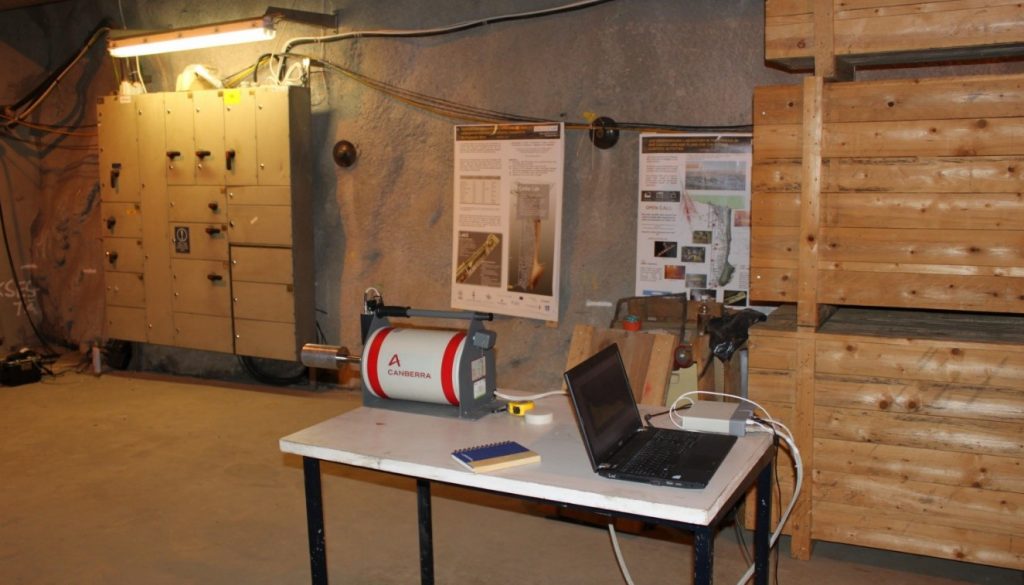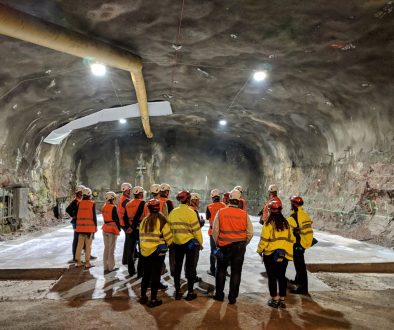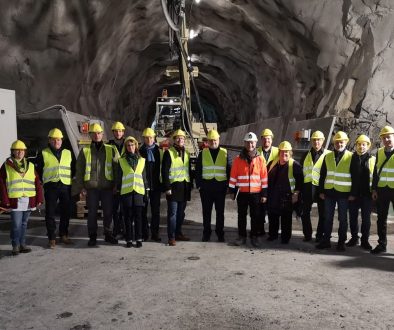Study of natural background radiation in Callio Lab (Finland)
The Callio Lab is one of the six underground laboratories participating in the BSUIN project. The natural background radiation (NBR) measurements were performed in Callio Lab (located in the Pyhäsalmi Mine (Finland)) in July 2018 by a group from the University of Silesia, Katowice, Poland. The NBR measurement carried out at a depth of 1436 m (~4000 m w.e.) in the felsic volcanic bedrock occurs.
The in-situ measurements were done in few localizations (Lab 2, Lab 1) by using gamma ray high-purity germanium (HPGe) semiconductor spectrometer and a RAD7 electronic radon detector (Durridge Company, Inc.). The main measurements were performed in Lab 2 near the far right corner of the experimental hall (dimension: 9 m x 15 m x 8 m; MP1). Additionally, two more measurements have been performed at the central points of Halls 2 and in Hall 1 (localizations MP2 and MP3). On the Fig. 1. the scheme of Lab with measuring points (MPs) and pictures of detectors’ during measurements are presented.
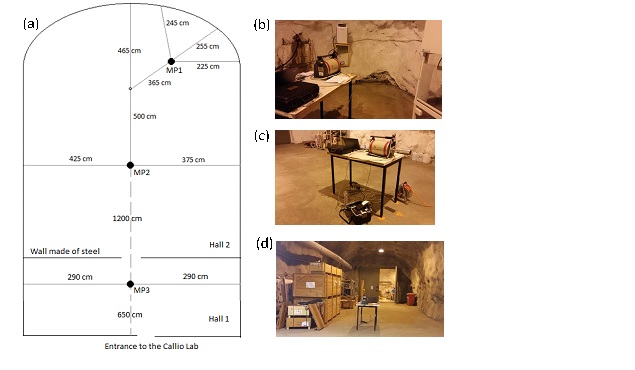 Fig.1. (a) the scheme of Lab 2 with measuring points (MPs); pictures of detectors’ positions: (b) HPGe spectrometer in MP1, (c) HPGe spectrometer and RAD7 monitor in MP2, (d) HPGe spectrometer in MP3 positioned in Hall 1.
Fig.1. (a) the scheme of Lab 2 with measuring points (MPs); pictures of detectors’ positions: (b) HPGe spectrometer in MP1, (c) HPGe spectrometer and RAD7 monitor in MP2, (d) HPGe spectrometer in MP3 positioned in Hall 1.
On the Fig. 2 the comparison of the gamma ray spectrum collected at MP1, MP2 and MP3 localizations is shown.
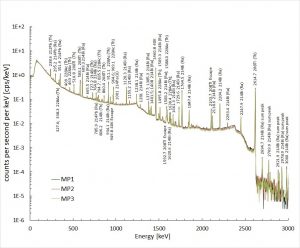 Fig. 2 Comparison of the gamma ray spectrum collected at MP1, MP2 and MP3 localizations.
Fig. 2 Comparison of the gamma ray spectrum collected at MP1, MP2 and MP3 localizations.
The integral count up to 2700 keV, the photon flux density, assessed on the base of full-energy peaks, and the total effective dose in three investigated localizations are presented in Tab. 1. The main contributors to the effective dose for investigated localization MP1 are 40K (35%), 214Bi (26%), from uranium series and 208Tl (22%) from thorium series.
Tab. 1. The results of in-situ measurement estimated on the base gamma ray spectrum and radon concentration measured in three localizations in Callio Lab. 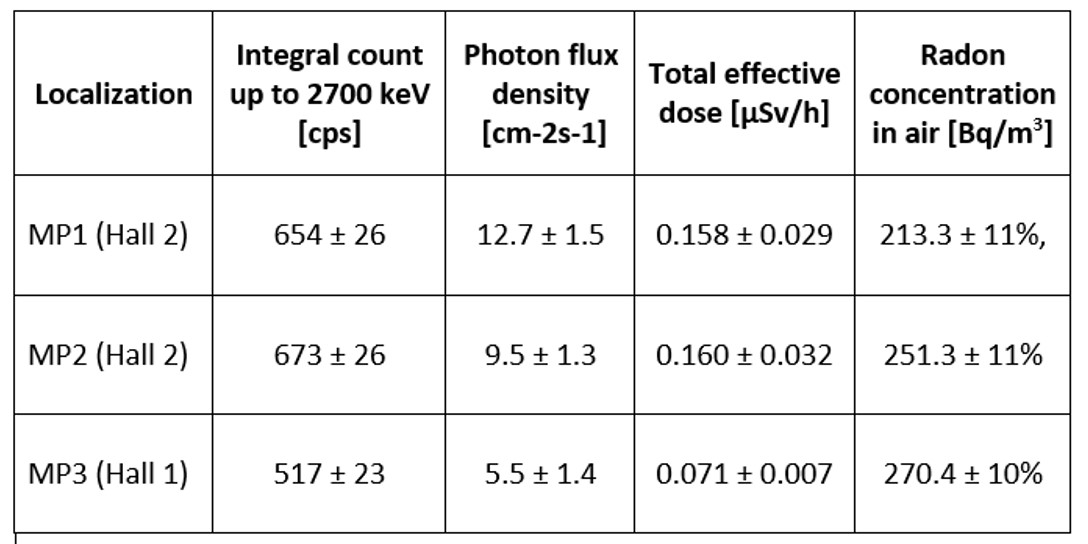
The concentration of 222Rn has been determined using RAD7 air-analyser. The measurements lasted 24–48 h with 1 h sampling time and did not show any time dependent structure. The results are presented in Tab. 1 and Fig. 3.
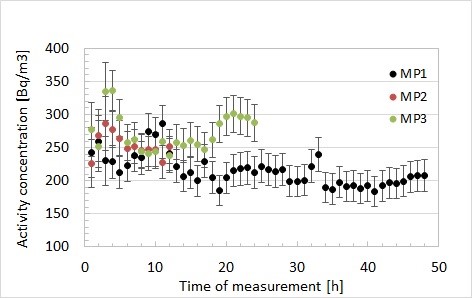 Fig. 3. Comparison of the radon concentration in MP1, MP2 and MP3 localizations.
Fig. 3. Comparison of the radon concentration in MP1, MP2 and MP3 localizations.
Additionally, rock and water samples were collected in and outside the Lab 2 and were analysed in Institute of Physics University of Silesia in Katowice (Poland). The radium and uranium concentration in water samples were measured by using liquid scintillation α/β counting (414 WinSpectral α/b LSC from Wallac) and alpha spectrometry techniques (α – spectrometer 7401VR from Canberra – Packard), respectively. While, the uranium, radium, thorium and potassium concentration in rock samples were measured by using alpha and gamma spectrometry technique. Before measurements of the radioisotopes by using α spectrometry and LSC technique the appropriate radiochemical procedures were applied [1-3].
The concentrations of uranium isotopes in rock samples varied from 1.4 ± 0.2 Bq/kg to 211 ± 10 Bq/kg and from 1.6 ± 0.2 Bq/kg to 212 ± 10 Bq/kg for 234,238U, respectively. The concentrations of radioisotopes (estimated by using HPGe detector) varied greatly depending on the place of sample collection in Lab 2. The values of 8.1 ± 0.4 Bq/kg to 188.2 ± 5.1 Bg/kg (average 45.6 Bq/kg) for 226Ra, of 2.6 ± 0.3 Bq/kg to 53.8 ± 3.1 Bq/kg (average 25.3 Bq/kg) for 232Th and of 104 ± 10 Bq/kg to 1136 ± 47 Bq/kg (average 453.8 Bq/kg) for concentrations of 40K were estimated.
In investigated water samples from Hall 2 Lab 2 the uranium 238U concentrations was below 0.5 mBq/L and 6.5 mBq/L for water sample collected outside Callio Lab 2. All water samples showed disequilibrium between 234,238U isotopes (in underground water it is a common phenomenon). All water samples showed 226Ra, 228Ra concentrations above the detection limits. The values of 15.1 ± 0.4 Bq/L to 116.6 ± 2.7 Bq/L for 226Ra and 6.1 ± 0.9 Bq/L to 36.0 ± 2.8 Bq/L for concentration of 228Ra. This may be due to that water to receive the radium isotopes from reservoir rocks or rocks are rich in radioactive content.
The presented results of natural background radiation measurements in this article are the part of the paper K. Polczek-Grelik et al., “Natural background radiation at Lab 2 of Callio Lab, Pyhäsalmi mine in Finland”, Nuclear Inst. and Methods in Physics Research, A 969 (2020) 164015. The similar measurements performed in other underground laboratory (Reiche Zeche mine- which also participate in BSUIN project) by our group, is presented in paper K. Polaczek-Grelik et al., “Characterization of the radiation environment at TU Bergakademie in Freiberg, Saxony, Germany”, Nuclear Inst. and Methods in Physics Research, A 946 (2019) 162652 and in our previous article on this BSUIN web-page (https://bsuin.eu/2019/03/21/study-of-natural-background-radiation-in-reiche-zeche-and-alte-elisabeth-shafts-freiberg-germany/).
References
[1] J. Suomela, Method for Determination of U-Isotopes in Water,” Swedish Radiation Institute, Stockholm, 1993.[2] C. W. Sill, Precipitation of actinides as uorides or hydroxides for highresolution alpha spectrometry, Nuclear and Chemical Waste Management, vol. 7, no. 3, pp. 201-215, 1987.
[3] Polish Norm PN-89/ZN-70072, Radium isotopes determination in water with LSC method. Wydawnictwa Normalizacyjne Alfa, 1989.

